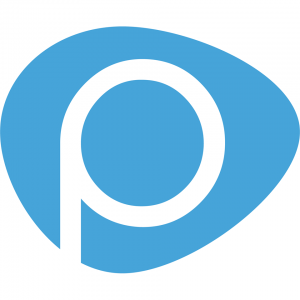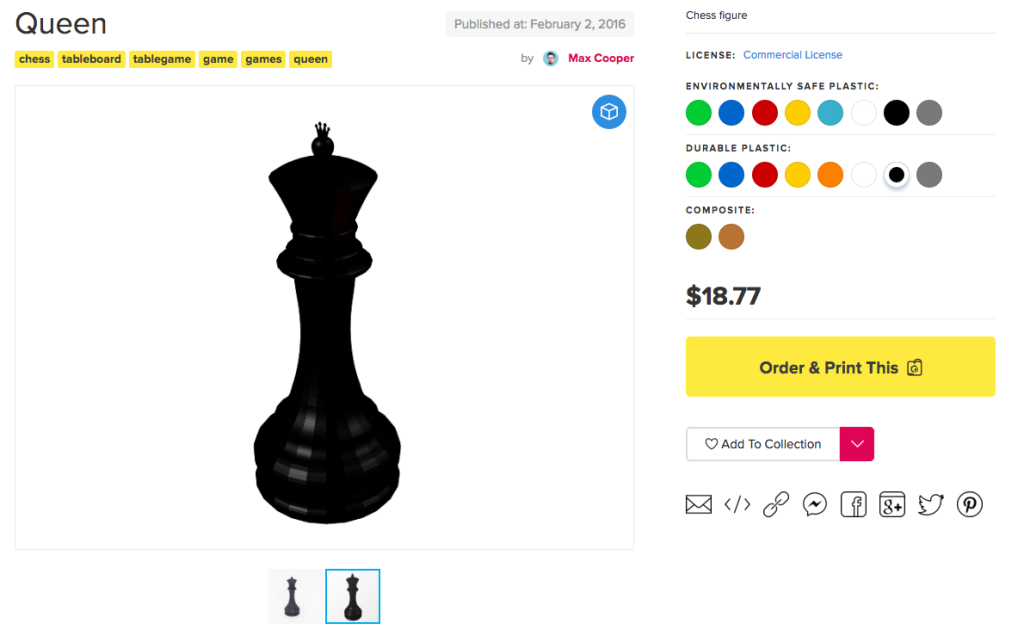Treatstock Says That it’s Time to Stop Giving Your 3D Models Away for Free, But is That Really the Answer?
![]() Quite a few 3D designers found themselves out of a home this week as 3D model marketplace Pinshape unceremoniously announced that they were going to be shutting down at the end of March. While there are obviously plenty of other options for 3D designers to settle down and share their work, it is never fun to lose an outlet that you had become comfortable with. Unfortunately that is an all too common occurrence when it comes to industries built around emergent technology. Those that lay the original foundations are not always there when everything is built up on top of them.
Quite a few 3D designers found themselves out of a home this week as 3D model marketplace Pinshape unceremoniously announced that they were going to be shutting down at the end of March. While there are obviously plenty of other options for 3D designers to settle down and share their work, it is never fun to lose an outlet that you had become comfortable with. Unfortunately that is an all too common occurrence when it comes to industries built around emergent technology. Those that lay the original foundations are not always there when everything is built up on top of them.
The reaction from the 3D printing community was mixed as these things typically are, but a common refrain that I heard was that the business model of a standalone 3D model marketplace is just unworkable. Naturally there needs to be an outlet for 3D printable content; most people with 3D printers are simply not going to be able to generate their own. But so far, monetizing that 3D content distribution hasn’t really worked very well. For companies like Thingiverse, where everything is free, monetization isn’t even an issue because it exists as an advertisement for MakerBot, and MyMiniFactory is similarly connected to iMakr.
 Pinshape may have found a last minute reprieve, and that is very good news, but that doesn’t change the fact that the industry is currently in a bit of a flux and a lot of companies aren’t going to be able to survive. It seems that 3D model marketplaces that aren’t connected to alternate revenue streams or existing enterprises are simply going to have a harder time, especially when trying to convince users to buy content that they can often get free elsewhere. After the news earlier in the week that Pinshape was going to be shutting down, Treatstock, a Delaware-based 3D model marketplace with a different business model, sent out an email with a simple message for 3D content creators: ‘stop selling your 3D models for free.’ But is it really that easy?
Pinshape may have found a last minute reprieve, and that is very good news, but that doesn’t change the fact that the industry is currently in a bit of a flux and a lot of companies aren’t going to be able to survive. It seems that 3D model marketplaces that aren’t connected to alternate revenue streams or existing enterprises are simply going to have a harder time, especially when trying to convince users to buy content that they can often get free elsewhere. After the news earlier in the week that Pinshape was going to be shutting down, Treatstock, a Delaware-based 3D model marketplace with a different business model, sent out an email with a simple message for 3D content creators: ‘stop selling your 3D models for free.’ But is it really that easy?
Here is Treatstock’s email in its entirety:
It is time to stop selling your 3D models for free!
For us, as for the entire community engaged in the 3D printing industry, the shutting down of Pinshape came as a complete surprise. However, we encourage all 3D artists and CAD engineers, who like us are happy with the progress of 3D printing, to not despair and continue to create. If you’ve created an awesome model, do not rush to give it away for free, thinking that it won’t be sold. On the contrary, we believe that any work that is well done should be paid well and this should be the focus of the business.
Perhaps people haven’t quite realized the full potential of 3D printing, but just remember there was a time when phones were only available to certain wealthy people, yet today it is difficult to find someone who is not familiar with these devices. It is obvious that in this age of advanced technology, progress is much faster, and something that was unreal and futuristic yesterday, today is just another device designed to make our lives easier. Maybe 3D printing technology is still in its infancy stage, but if you look at the evolution of what has already occurred, it becomes clear that the market will inevitably grow.
Whilst we acknowledge there are gaps in the legislation to protect copyright for 3D printable objects, we believe it is only a matter of time before this will all change. To solve this problem on our end, we decided to get rid of Creative Commons license and just use commercial license, with the possibility for authors to still publish their models for free. Nevertheless, we will not put up with the abuse of intellectual property of models presented on our website and if necessary, we will always ensure to take all appropriate measures, all the way up to a court appeal if necessary.
The main problem is that 3D printing technology is still too complicated for ordinary users. Modern 3D printers require constant calibration and adjustment of slicers settings as well as all other settings. This should be dealt with by professionals, not by ordinary users who are not interested in the nuances of technology. The main thing that interests the customer is the finished product. This is what we offer at Treatstock. The user chooses a favorite model and then selects the most convenient print service to print. They do not have to worry about how to print the desired item, we have already taken care of it. So if you like, we believe in the bright future of 3D printing market, and welcome to Treatstock!
The business model that Treatstock uses is actually pretty close to Pinshape; designers are encouraged to upload their 3D models and set a price. Users are given the option of not charging for the model, but if they do set a price and sell some Treatstock takes a small cut and gives the rest to the creator. Unlike Pinshape, however, Treatstock also has 3D printing services available to its users, so if someone finds a 3D model that they want but are unable to print it themselves they can find a local 3D printer to do it for them.
The Treatstock business model sounds like a good one, but I’m not sure how much of a difference there is between them and Pinshape, really. It isn’t as if Pinshape users can’t easily find 3D printing services via 3D Hubs or Shapeways, and Treatstock’s questionably timed email failed to really address a very real issue with 3D model marketplaces: 3D printing is still pretty expensive. Yes, I may be able to find a great chess set on Treatstock, and as advertised they easily connect me to local printing service providers, but is it realistic that I’ll choose to print out a single chess piece for almost twenty bucks? Especially when I need to buy the 3D model as well?
Let’s be honest, no one is going to print out a chess set at twenty dollars for each piece when they can buy an entire set at a store for less. And look, I’m a content creator myself, so I would never advocate that anyone give away their work for free. But realistically the only objects that people are going to have 3D printed in any significant numbers are things that are unique and can’t be found elsewhere for a better price. 3D printing is already a niche industry, and that just makes it even niche-ier. I’m not going to pretend that I have an answer here; if I did know how to monetize 3D content that made it profitable for the designers and a company alike I’d probably be rich right now.
While I’m certainly happy that Pinshape was able to find a way to keep their doors open, and Treatstock has an intriguing business model that has potential, there simply aren’t enough people willing to buy 3D content right now. Much less enough people willing to pay high prices to have it 3D printed for them. I don’t think simply encouraging 3D content creators to charge for their work is necessarily the correct strategy. The problem isn’t the designers; they are doing great work and frankly it is a little unreasonable to put the onus for generating money on them. The problem is an industry that isn’t being very creative with content distribution and cost reduction, and 3D model marketplaces simply need to find better ways to generate revenue beyond charged downloads or 3D printing service referrals. And until that happens, 3D content creators are going to have to be more creative with how they generate revenue from their designs, and sites like Pinshape and Treatstock are probably going to continue to struggle. Do you think designers should give away 3D files for free? Discuss in the Pinshape & Treatstock 3D Models forum over at 3DPB.com.
Subscribe to Our Email Newsletter
Stay up-to-date on all the latest news from the 3D printing industry and receive information and offers from third party vendors.
You May Also Like
Precision at the Microscale: UK Researchers Advance Medical Devices with BMF’s 3D Printing Tech
University of Nottingham researchers are using Boston Micro Fabrication‘s (BMF) 3D printing technology to develop medical devices that improve compatibility with human tissue. Funded by a UK grant, this project...
3D Printing Webinar and Event Roundup: April 21, 2024
It’s another busy week of webinars and events, starting with Hannover Messe in Germany and continuing with Metalcasting Congress, Chinaplas, TechBlick’s Innovation Festival, and more. Stratasys continues its advanced training...
3D Printing Webinar and Event Roundup: March 17, 2024
It’s another busy week of webinars and events, including SALMED 2024 and AM Forum in Berlin. Stratasys continues its in-person training and is offering two webinars, ASTM is holding a...
3D Printed Micro Antenna is 15% Smaller and 6X Lighter
Horizon Microtechnologies has achieved success in creating a high-frequency D-Band horn antenna through micro 3D printing. However, this achievement did not rely solely on 3D printing; it involved a combination...






























